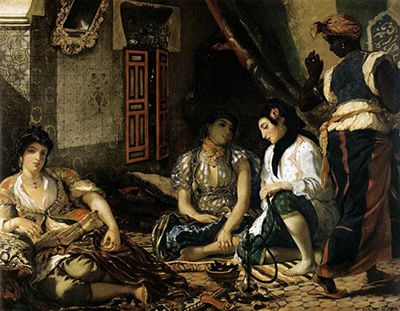A summit of Eugene Delacroix's art, The Women of Algiers, was painted after he went through an entertaining voyage to North Africa.
Women of Algiers gives a perfect analysis and presents an exact point of balance between Classicism and Romanticism.
The unexplainable uniform ordering of style, and the controlled passion are Classical; the expressive array of colours, and the oriental inspiration purely Romantic. The lighting and its reflection plays an ornamental role.
The colours and all its subtle values shows an atmosphere filled with warmth in a setting only Diego Velazquez in the Spinners had known how well to suggest it.
As a champion of Impressionism, it is no doubt Eugene Delacroix employed a vibrant tachisme while he juxtaposed the brushstrokes, as seen in the material that the reclining woman's hand rests or the cushion that is placed to the left.
Both Pablo Picasso and Pierre-Auguste Renoir were deep admirers of this painting. In fact, this painting fueled and was the force behind most of their version of the Algerian women.
The Salon of 1834, left the critics sharply divided. However, the work was greatly commended at the Revue des Deux-Mondes by Gustave Planche.
Planche emphasised that this was a capital piece that holds the interest of its audience exclusively through the painting and insists on its non-correlations with literary nonsense of idlers.
In addition to this, Gustav Planche insisted that the painting marked the peak of M. Delacroix's intellectual life – the most amazing triumph that M. Delacroix had ever achieved.
The first version of the Women of Algiers was painted in 1834 in Paris and is now situated in Louvre, Paris in France.
The second version was painted nearly 15 years later between 1847 and 1849, which is now located in Musee Fabre, Montpellier in France. Both works depict a similar scene of four women in an enclosed room.
Even though the setting is similar, the two versions evoke different moods.
This is particularly true when considering the display of the depiction of the women. The 1834 version clearly captures the disparity between the viewer and the women, while the later version invites the viewer through the woman's warm gaze.




